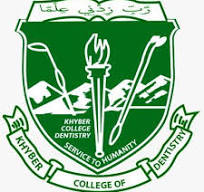FREQUENCY OF ENDODONTIC FLARE UP ACCORDING TO PULPAL AND PERIRADICULAR DIAGNOSIS AT REHMAT MEMORIAL HOSPITAL ABBOTTABAD
DOI:
https://doi.org/10.33279/jkcd.v15i01.712Keywords:
Flare up, peri apical infection, irreversible pulpitisAbstract
Objectives: To determine the frequency of endodontic flareup and its association with pulpal and peri radicular diagnosis in teeth receiving root canal therapy.
Materials and Methods: From June 10, 2021, to March 15, 2022, 101 patients aged 10 to 60 years were included in a descriptive case series.The sample size was determined using WHO software with a confidence level of 95%, an expected proportion of endodontic flare-up of 7%, and absolute precision of 5%. Non-probability consecutive Sampling technique was used for data collection. The study was conducted at the Restorative department of Rehmat memorial dental teaching hospital, Abbottabad, to determine the frequency of endodontic fl are-ups based on pulpal and peri radicular diagnoses.
Results: The study participant’s mean age was 33.62±11.57 years. Of the total 101 participants, 42 (41.58%) were females and 59 (58.42%) were males. Irreversible pulpitis, which aff ected 57 patients (56.44%), was the most requent diagnosis of teeth requiring root canal therapy while pulp necrosis, which aff ected 14 patients (13.86%), was the east common diagnosis . Pulp necrosis (6.93%) was the most frequent diagnosis associated with endodontic flare-ups out of total 14 reported cases, followed by irreversible pulpitis (3.96%), and, least frequent diagnosis associated with flare up was periapical pathology (2.97%).
Conclusion: In our set-up, the frequency of endodontic fl are-ups (13.86%) is signifi cantly higher. Irreversible pulpitis, peri-apical pathology, and pulp necrosis are the major diagnoses associated with endodontic flare-ups.
References
Alves Vanessa de Oliveira. Endodontic fl are ups: a prospective study.Oral Surgery, Oral Medicine, Oral Pathology, Oral Radiology and Endodontics, Volume 110, Issue 5 DOI: https://doi.org/10.1016/j.tripleo.2010.05.014
Sharma A, Mandli J, Varghese R. An Overview of Etiology of Endodontic Flare ups. Indian J ConservEndodont 2016;1(3):76 -80
Onay EO, Ungor M, Yazici AC. The evaluation of endodontic fl are ups and their relationship to various risk factors. BMC Oral Health. 2015;15(1):142. DOI: https://doi.org/10.1186/s12903-015-0135-2
Kaur, Pushappreet. (2015). Endodontic flare ups: A proposal for etiopathogenesis and psychological management. International Journal of Health. 3. 42. 10.14419/ijh.v3i2.5145 DOI: https://doi.org/10.14419/ijh.v3i2.5145
Jayakodi H, Kailasam S, Kumaravadivel K, Thangavelu B, Mathew S. Clinical and pharmacological management of endodontic fl are -up. J Pharm Bioallied Sci. 2012;4(Suppl 2):S294. DOI: https://doi.org/10.4103/0975-7406.100277
Ahmad AK. Eff ect of long acting anesthetic on post Op pain in teeth with Irreversible pulpitis; randomized clinical trial. Saudi Pharm J. 2014;22(1):39 -42. DOI: https://doi.org/10.1016/j.jsps.2013.01.004
Azim, A.A., Azim, K.A. & Abbott, P.V. Prevalence of inter-appointment endodontic fl are-ups and host-related factors. Clin Oral Invest 21, 889–894 (2017) DOI: https://doi.org/10.1007/s00784-016-1839-7
Manuja Nair JR, Devadathan A, Mathew J. Incidence of endodontic fl are-ups and its related factors: a retrospective study. J Int Soc Prev Community Dent. 2017;7(4):175 DOI: https://doi.org/10.4103/jispcd.JISPCD_61_17
Alghazaly A, Al Habib L. Management of Endodontic Flare-Up in the Presence of Periapical Radiolucency: Case Report and Overview. Cureus. 2023 Nov DOI: https://doi.org/10.7759/cureus.49719
Iqbal M, Kurtz E, Kohli M. Incidence and factors related to flare ups in a graduate endodontic programme. Int Endod J. 2009;42:94 –104. DOI: https://doi.org/10.1111/j.1365-2591.2008.01461.x
Gbadebo SO. Endodontic fl are up: incidence and association of possible risk factors. Afric J Med Med Sci. 2016;45(2):207
Chen, Yi-Fen & Lin, Yu-Hen & Chen, Cheng-Chang & Chen, Hui-Ling. (2007). Endodontic flare-ups and associated factors in a Taiwanese hospital. Journal of dental sciences. 2. 39-44.
Rehman Khattak S, Sana, R, Khattak Y, Alam, F, & Khan M. Z. Factors Associated with Endodontic Flare Ups. Journal of Gandhara Medical and Dental Science, 2016(2), 14–20. DOI: https://doi.org/10.37762/jgmds.2-2.51
Downloads
Published
How to Cite
Issue
Section
License
Copyright (c) 2024 Bushra Irum, maham shafique, bakhtawar mumtaz, atikah sagheer, sadia farid malik

This work is licensed under a Creative Commons Attribution-NonCommercial-NoDerivatives 4.0 International License.
You are free to:
- Share — copy and redistribute the material in any medium or format
- Adapt — remix, transform, and build upon the material
- The licensor cannot revoke these freedoms as long as you follow the license terms.
Under the following terms:
- Attribution — You must give appropriate credit , provide a link to the license, and indicate if changes were made . You may do so in any reasonable manner, but not in any way that suggests the licensor endorses you or your use.
- NonCommercial — You may not use the material for commercial purposes .
- No additional restrictions — You may not apply legal terms or technological measures that legally restrict others from doing anything the license permits.










